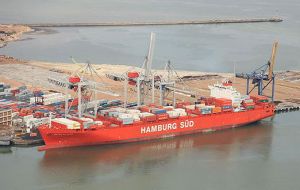MercoPress. South Atlantic News Agency
Hamburg-Sud largest container vessel tested Montevideo port’s efficiency
 Container vessel “Rio de la Plata” operating in Montevideo Port
Container vessel “Rio de la Plata” operating in Montevideo Port Hamburg Sud “Rio de la Plata”, the first of a newbuilding series of six identical vessels with a slot capacity of 5.900 containers (and 1.365 reefer container plugs) called last month in Montevideo.
At a length of 286 meters, the “Rio” class is precisely one bay longer than the 5,552TEU “Monte” class vessels which will be gradually phased out by the German maritime company.
But “Rio de la Plata” was also a test for Uruguay’s main port and its efforts to remain updated, competitive, with efficient time-saving services and committed to the implementation of its ongoing expansion and innovation plans.
With a displacement of 80.455 tons and a draught of 13.50 meters, Hamburg Sud’s largest-ever container vessel in the company’s history was able to dock in Montevideo because of the consistent maintenance-policy from Uruguayan authorities to dredge the access channel as well as the port’s ample bay.
Similarly the operator of the Montevideo port terminal, TCP has invested heavily in equipments and facilities for the handling of an ever increasing number of containers and larger vessels such as the Hamburg Sud “Rio” class ships, in line with the global trade tendency.
The fact that “Rio de la Plata” called in Montevideo was evidence that the port has the sufficient space capacity and handling facilities for vessels transporting growing numbers of containers. Equally significant this ensures Montevideo as a call port for the main maritime operators, supported by an infrastructure of competitive costs, particularly in recession times, told MercoPress Santiago Rigby, General Manager of Hamburg-Sud office in the Uruguayan capital.
Uruguayan authorities have realized that the greater the volume of containers handled, the lower the cost per unit and the more attractive a port becomes for maritime agencies and the possibility of being considered as a regional hub
Actually Uruguay more than ten years ago voted a new legal framework for port activities, in effect handing to the private sector the initiative of transforming the century old facilities into a modern, efficient, highly productive terminal. Since then volumes handled in the port have not ceased to grow and Montevideo has become a formidable reference for the region.
The port is known for its reliability, low costs, high productivity, minimum labor strife and its long historic advantage as a natural complement to the other big port in the River Plate, Buenos Aires.
Anyhow these are testing times for all sea terminals world wide. With recession, global trade is forecasted to contract, there’s idle capacity and keeping operational costs down and efficiency levels has become the great challenge.




Top Comments
Disclaimer & comment rulesCommenting for this story is now closed.
If you have a Facebook account, become a fan and comment on our Facebook Page!